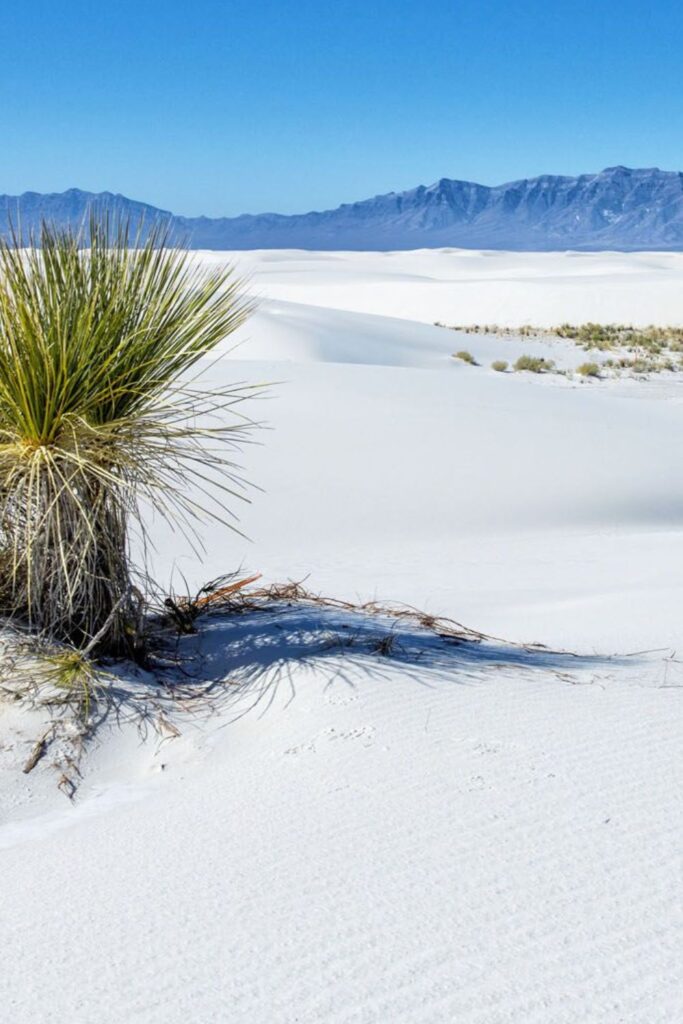
Fun and Exciting Things to Do White Sands National Park
We may earn money or products from the companies mentioned in this post.
One of the most unique places in all of New Mexico is a place called White Sands, so named because of the huge dunes of gypsum sand which cover the 275 square miles of desert called the Tularosa Basin. White Sands National Park is located at the north end of the Chihuahuan Desert and is so barren that even the few plants and animals that do exist there struggle to do so.

The animals which have survived have adopted a white skin coloring to blend in with the ever-blowing sands. The National Monument of White Sands New Mexico is considered one of the world’s greatest natural wonders and is visited by hundreds of thousands of people each year.
The crystal-like sand is so white that it gives the appearance, from a distance, of being snow-covered ground. There are many reasons why people go to White Sands, New Mexico. Sure, they want to view the unique terrain, but biking, hiking, and camping are also the main attractions there. Sightseeing along Dunes Drive is a spectacular experience, along with stopping for a picnic at the Heart of the Dunes.
At the White Sands Visitor Center, you can get tons of information about the area, or visit the book store or the museum. The museum has displays featuring various attractions in the area, along with information about plants, animals, and the history of the desert.
And of course, there’s a gift shop where you can take home souvenirs and memorabilia like t-shirts and coffee mugs. From Memorial Day to Labor Day there are nature walks with the desert rangers giving guided tours. Evening slide shows are a relaxing way to spend a portion of the night, then a sunset stroll and the rest of the evening can be spent stargazing. The clear desert atmosphere is perfect for seeing hundreds of twinkling stars against an almost black sky.

It’s about 8 miles by vehicle from the Visitor Center to the Heart of the Dunes and there are various places where you can pull over and see exhibits about nature and the history of the area, or take photos and walk. And if you prefer to see the dunes on foot, The Big Dune Trail is a mile-long hike full of sight-seeing opportunities.
Plants and animals are featured in a booklet which you can carry along the trail to point out interesting spots. Or, The Alkali Flat Trail which begins at the end of Dunes Drive is an unforgettable hiking experience of about four and a half miles that goes straight to the heart of the dunes. Although not many birds live in the gypsum dune field, over 200 different types of birds have been spotted in the surrounding foothills, lakes, and plains. The Visitor Center is reportedly the best place to catch glimpses of the various birds.
Especially for the kids, there are fact sheets and lists, by grade level, of suggested reading about geology, plants, and animals in the White Sands area. And kids can become Junior Dunes Rangers by joining the program for four to thirteen-year-olds who are visiting. This is a fun way that kids can learn all about the park and help the rangers with their duties.
Nearby is the White Sands Missile Range where various weapons are tested by the U.S. military, causing the Dunes Drive to be closed occasionally. Visitors are asked to call the day before to make sure the Dunes Drive will be open the following day.
When Dunes Drive is closed for these purposes, it’s usually only closed for about three hours, allowing you to make earlier or later arrangements. White Sands, New Mexico is a must-see for people who love to view unique natural wonders and for those who love to travel.
White Sands National Monument contains the world’s largest gypsum dune fields. Administered by the National Park Service, White Sands offers fun in the sun and sand for the whole family.
The sparkling white sands were set aside as a national monument in 1933 by President Herbert Hoover who wanted to preserve the beauty of this natural wonder. White Sands National Monument is a popular place for picnics, hiking, family reunions, and sand play.
Activities at White Sands National Park
The scenic drive through the dunes is about eight miles long with frequent signs along the way. As the white sand dunes shift over time, as much as 30 feet per year, the drive and picnic areas must be moved so the drive is always changing. There are group picnic areas inside White Sands National Monument as well as individual sites. Each site has a grill, a shaded table, and lots of flat, packed sand for volleyball and other sports. Pets are allowed on leash – please clean up after them.
White Sands has more than six miles of marked hiking trails but you are not restricted to the trails. Bring plenty of water, sunglasses, and sunscreen if you plan on hiking. Because it’s very easy to get disoriented in the dune fields, bring a compass if you plan on hiking off the marked trails. Mountains to the east and west and occasional water towers serve as recognizable landmarks.
Sand Surfing at White Sands National Park

The tall steep dunes at White Sands are perfect for sliding down. Half a century ago, I remember my uncle sanding and waxing his surfboards for fast trips to the bottom. We would trudge to the top of the highest dunes around and let gravity do its thing. I had a little sled-shaped board that I could sit on and ride to the bottom. My uncle had narrower boards and he rode them down while standing up. Sure we had lots of tumbles but the sand is soft and rolling down the hills is more fun anyway. Today, you can rent boards at the visitor’s center or buy plastic toboggans.
Special Events at White Sands National Park
Throughout the year, mostly during the summer months, there are ranger-guided tours and special demonstrations. Check with the visitors center. During the summer months, White Sands is open on the full moon. The sparkling dunes are magnificent under the bright moon.
Why are White Sands Different?
White Sands is different for several reasons. The most obvious one is that there are approximately 135 square miles of sand, but no ocean or any other body of water that we are used to seeing around the sand. Secondly, White Sands are different because it is gypsum crystals and gypsum is water soluble. Therefore, gypsum is rarely found in the form of sand.
Typically, when it rains the gypsum would melt and is carried to a nearby body of water. Since there is no water near White Sands, the rain forms shallow pools that dry out and leave the gypsum on the surface. The gypsum crystals are then broken down by the weather and erosion and they become sand-size grains that the wind blows into sand dunes.
The third thing about White Sands that is different is the fact that only the top few inches of gypsum dunes are actually loose sand. When the rain falls and dissolves the gypsum, it makes a crude form of plaster of Paris making the white sand dunes easier to walk on than most sand.
Also, the gypsum does not generate heat like quartz-based sand crystals normally do, so you can comfortably walk on your bare feet in this sand in the hottest of weather. Lastly, White Sands is the site of Trinity Site where the first atomic bomb was detonated in 1945.
The White Sand Missile Range is on this site and several times a week the monument is closed while testing is done. When you plan your trip to White Sands, you really should check to be sure they are not testing during the time you plan to visit.
Things to Know About White Sands
As White Sands is a protected environment, it is against the law to remove sand, rocks, plants, or animals from the area. The beautiful white sand is poisonous to your houseplants or your fish tank so don’t bother. Bring sunscreen and use it. The brilliant white surfaces reflect sunlight so the under chin needs sunscreen as much as the tops of your ears. Keep hydrated. The desert air dries you out quickly.
